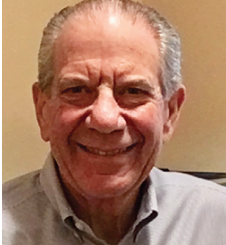
 What is? Well, it’s the Raising the Awareness of Mechanical Insulation initiative we began some years ago. This has been a long, tough slog and it’s not over by any stretch. We seem to climb a mountain, satisfied we’ve achieved that height, only to see the next mountain off in the distance. Then, off we go again. Think of that song you can never get out of your mind: “The bear went over the mountain …” Sorry, I couldn’t help it.
What is? Well, it’s the Raising the Awareness of Mechanical Insulation initiative we began some years ago. This has been a long, tough slog and it’s not over by any stretch. We seem to climb a mountain, satisfied we’ve achieved that height, only to see the next mountain off in the distance. Then, off we go again. Think of that song you can never get out of your mind: “The bear went over the mountain …” Sorry, I couldn’t help it.
The challenges seem to be ever-present, but with dedication and perseverance coupled with a reasoned approach to why it makes good sense to promote mechanical insulation (MI), we’ve made terrific headway. Going forward, we will be taking the Raising the Awareness of Mechanical Insulation concept in some new directions; but first, let’s take a look at what we’ve accomplished. This is by no means a full description. Keep in mind that increased mechanical insulation thicknesses is not a complete solution to the energy use issue, but it is an integral part of a total approach to make this a better world for future generations.
The National Energy Code for Buildings-2015 (NECB-2015) has was published February 2016 and is already influencing the mechanical insulation market. All provinces are fully aware of NECB-2015’s implications and these jurisdictions are moving ahead (at different speeds, mind you) with bringing their own energy efficiency requirements into play.
ASHRAE publishes energy standards every three years, and so ASHRAE 90.1-2016 is out. Each publication ups the bar when it comes to the overall energy efficiency of buildings; however, when it comes to the requirement for minimum pipe insulation thicknesses, we reached the point of diminishing returns with ASHRAE 90.1-2010. What is referred to as the minimum pipe insulation thickness is, in reality, the optimum pipe insulation thickness. The minimum pipe insulation thicknesses in both NECB-2015 and ASHRAE 90.1-2010 increased in some cases by as much as 50 per cent over previous versions.
The methodology used to determine the minimum pipe insulation thicknesses is based on a very specific set of criteria, and these criteria are stipulated in the respective tables. Once you step outside of these parameters (e.g. high humidity areas and outdoor applications), separate calculations are required. The opportunity then exists for increased thicknesses in “off- table” applications.
Leadership in Energy and Environmental Design (LEED) is well established. LEED v4 is now in effect and with it the requirement for increased mechanical insulation thicknesses is evident. LEED v4 references both NECB-2010 and ASHRAE 90.1-2010 and states if there is a conflict between the two, then the higher standard applies. In our case that means the minimum pipe and duct insulation thicknesses in ASHRAE 90.1-2010 prevail.
The United States Green Building Council (USGBC) very recently (December 2016) published a list of where countries rank in terms of the number of LEED projects outside of the US. Imagine that. Canada is in second place behind China. Who would have thought that, but there it is. Every one of the Canadian LEED projects requires mechanical insulation thicknesses increased over what was required in the past.
Insulation contractors are installing greater wall thicknesses and distributors will tell you their inventory mix has shifted dramatically. Just remember, TIAC is directly and indirectly involved in these changes.
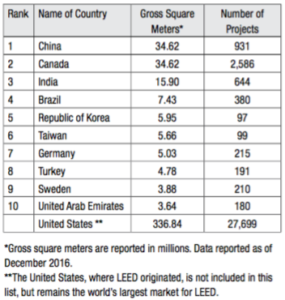
As we move into 2017 and beyond, the code development work at the federal and a few provincial levels is paying off and will continue to do so.
A similar theme but a new direction
This year, we’re going to be taking a look at potential in a few different areas:
- Mining: We have taken booth space at the largest mining event in Canada. It will be held in Montreal in May. This is an exploratory area for TIAC. We know insulation is sold into mining projects, but where and how much has proven elusive. We anticipate we will develop contacts and initiate a strategy around these.
- Hospitals: Our participation in several Canadian Healthcare Engineering Society (CHES) trade shows has given us excellent insight as to where the potential for improved MI exists. Some TIAC members have been benefiting from this exposure. This year we will continue to have a booth at CHES trade shows, but we will focus on the smaller chapters, and of course still attend the national conference.
- Secondary education facilities: We’ve barely scratched the surface when it comes to fully engaging this sector, so we will continue to participate in trade shows where these occur in Canada.
- Food and beverage: We are in a good position to be invited to give an MI presentation at one of this industry’s meetings sometime this year.
- ASHRAE: We will continue to offer up TIAC as a resource for the latest information as well as best practices, and we will do this through chapter presentations.
Code development work is on going at the federal and provincial levels:
• We are seeing how NECB-2015 is influencing provincial building and energy codes.
• We will continue to provide comments during the public review periods relating to potential code changes. For example:
•We submitted our view that the maximum surface temperature of mechanical equipment be reduced from 70 degrees C to 40 degrees C.
- The spray foam insulation industry made application to allow spray foam to be applied to the exterior of ducts. You read that correctly—spray foam insulation on ducts. Our comments fully opposing this request were submitted, comprised of seven points against including specific statements in the building code supporting our position.
- We submitted comments regarding mandated water use benchmarking, stating the evaluation of the condition and efficiency of pipe insulation be part of the process.
- We made similar comments with respect to mandated energy benchmarking requirements.
- We will be submitting comments relating to MI for inclusion in the National Plumbing Code of Canada (NPC). These comments will focus on acceptable trade practices for the plumbers, where these trade practices are contrary to energy efficiency requirements in the NECB- 2015. I understand the NRCan personnel responsible for the NPC have an interest in creating a standardized approach to energy efficiency in the NBC, NECB, and NPC. Stay tuned.
As we attend trade shows and engage numerous attendees, what has become a very loud and clear message from mechanical engineers is that we, as an association, must address poor workmanship. We need to educate mechanical contractors and plumbers about the importance of MI best practices. We need to offer our services to update and upgrade mechanical insulation specifications. To illustrate these points, take a look at these job-site photos sent to me by mechanical engineers:
- Figure 1: The copper pipe riser was installed hard up against a supporting piece of plywood leaving no room for the pipe insulation to go completely around the pipe.
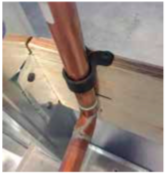
- Figure 2: The diameter of the coring is too small to allow for the proper installation of firestop material.
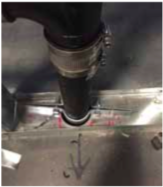
- Figure 3: The installer didn’t have a clue and actually argued with the mechanical engineer that the application was correct and the problem was the fault of the specification and the product.
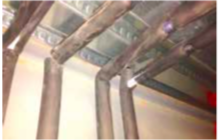
It would be a daunting task to address these issues nationally, given the limited resources TIAC has at its disposal. Having said that, we absolutely need the TIAC membership to step in at their respective local levels and find out where the schlock operators are hiding. We are the industry that can best educate, promote, define quality, and engage the various elements responsible for poor quality workmanship. We need a strategy that will allow the BCICA’s Quality Assurance Program to be rolled out nationally and become an integral part of all mechanical insulation specifications.
TIAC is here to help. We have access to excellent resources. We have established our credibility in the marketplace. Why not take advantage of all of this?



